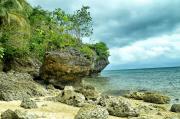Located in Biñan City, Laguna, right across the Laguna Technopark district, De La Salle University — Canlubang or De La Salle Canlubang (DLSC) is a member institution of De La Salle Philippines. Established in 2003, the campus was built on 55 hectares of prime property donated by the family of the late National Artist for Architecture Leandro Locsin (HS 1947). De La Salle-Canlubang offers kindergarten, elementary, secondary and tertiary education which centers on science and technology.
Laguna is fast becoming the country's industrial and technological site. Its large, industrial companies presently make it the home of the first Science Technological Park. In response to the ever-quickening pace of scientific and technological development of modern times, the concept of a three-level science and technology oriented school took root. Hence, De La Salle Canlubang was established in June 2003 in order to address the educational concerns of our nation with its youth as its strength. They are envisioned to be grounded on science and technological skills cloaked in the ideals of St. La Salle as an answer to the demands and challenges of the 21st century.
The integrated school opened its doors to 240 students from preschool to grade 4 and grade 8 (second year high school) during its first year. The curriculum adapts to science education as its basis. Science emphasizes hands-on exploration and direct experience with the natural world; thereby producing young scientists who are well-rounded and whose strength include: science and technological skills, clear-analytical thinking, and scientific literacy, to be active members of society.
Campus
- Milagros R. del Rosario Building
The first building to be constructed on campus is the four-storey Milagros V. del Rosario Building, which houses the school's administrative offices and classrooms. The building was donated to the school by Ambassador Ramon V. del Rosario. The building has 35 classrooms, a 200-seat auditorium, three audio-visual rooms, three libraries, a media lab, a dark room for the photography students, a radio station, a children's playroom, a robotics classroom, and three computer laboratories. Construction began in April 2002 and was completed in June 2003 and was designed by the firm L.V. Locsin and Partners.
- Integrated School Building
The Integrated School Building houses the classrooms and other spaces for the Nursery to Grade 3 students of the Integrated School. The building also houses a canteen of its own and it stands beside the Pergola.
- Pergola
The Pergola is a multi-purpose hall for the students. It stands beside the new Integrated School Building. The covered area acts as a special venue with several functions for the different activities of the Academic Community.
History
The Brothers of the Christian Schools, officially known as Fratres Scholarum Christianarum or FSC, is a congregation dedicated to the teachings espoused by St. John Baptist De La Salle.
The first De La Salle School in the Philippines was opened on June 16, 1911 along General Luna, Paco, Manila at the request of the Archbishop of Manila. In 1921, the school was moved to its present site on Taft Avenue. Unable to accommodate requests for admission to the elementary grades, they had reversed an earlier policy not to expand. To date, they have spread out to different provinces. The Brothers have since opened in Greenhills, Antipolo, Lipa, Bacolod, Ilagan, Dasmarinas, and Alabang. They have also undertaken supervision of some schools in Manila, Cavite, Bataan, Cebu, Bukidnon, Surigao del Sur, Negros Occidental, Masbate, Capiz, and Ozamis. Today they are known as De La Salle Supervised Schools.
Around 1977, the idea of having another La Salle School, this time in the Laguna area was conceptualized. This was when Architect Lindy Locsin, then a member of the DLSU board of Trustees, offered to donate several hectares of his family's land to La Salle. In 1997, this generous donation of the Locsins was realized. La Salle purchased additional contiguous hectares making De La Salle Canlubang a sprawling fifty hectare campus.
Today, De La Salle Canlubang Integrated School has grown to be one of the most progressive schools in the south with a population of more than 1,000 students from Kinder 1 to Grade 11 geared towards producing lifelong learners with the spirit of Faith, Service and Communion and equipped to meet the challenges of the new 2000 millennium.
How to get there
Access to the campus is via the South Luzon Expressway off the Santa Rosa exit to Tagaytay City.










